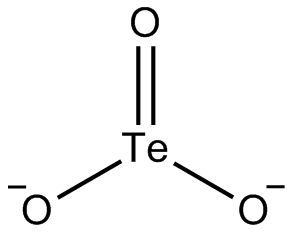Top Qs
Timeline
Chat
Perspective
Tellurite
Ion From Wikipedia, the free encyclopedia
Remove ads
Tellurite is a oxyanion of tellurium with the formula TeO2−
3. It is the ion of tellurous acid, and is chemically related to tellurium dioxide (TeO
2), whose mineral appearance also bears the name tellurite. Tellurites are typically colorless or white salts, which in some ways are comparable to sulfite.[3]
Remove ads
Structure and reactions

Tellurite dianion is pyramidal, like selenite and sulfite. The anion has C3v symmetry.
Tellurites can be reduced to elemental tellurium by electrolysis or a strong reducing agent. When fused with nitrate salts, tellurite salts oxidize to tellurates (TeO2−
4).
Upon acidification of aqueous solutions of tellurite salts, solid hydrated tellurium dioxide (TeO2) precipitates. This reaction allows the separation of tellurium from selenium since selenous acid remains soluble at low pH. The intermediate in the protonation occurs at oxygen to give [TeO2(OH)]−.
Remove ads
Compounds
- Sodium tellurite
- Potassium tellurite (K2TeO3) is used together with agar as part of a selective medium for growth of some bacteria (Clauberg medium). Corynebacteria and some other species reduce TeO2−
3 to elemental Te, which stains the bacteria black.
Biological activity
Tellurite (TeO₃²⁻) is a highly toxic oxyanion of tellurium with notable biological activity, particularly due to its toxic effects on various organisms, including bacteria, plants, and humans. The lack of mitochondrial proteins MRPL44, NAM9 (MNA6) and GEP3 (MTG3) in yeast is associated with resistance to tellurite.[4]
See also
References
Further reading
Wikiwand - on
Seamless Wikipedia browsing. On steroids.
Remove ads

